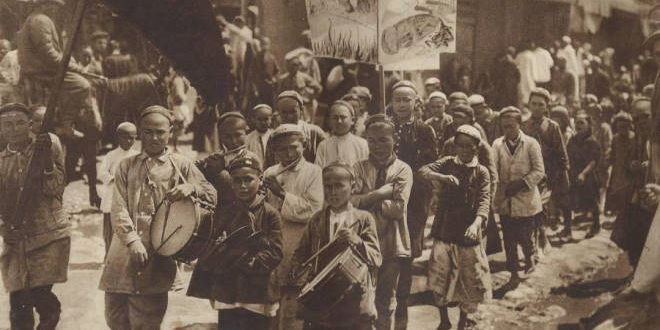The wave of refugee movement from West to East that swept across Russia reached the Turkestan Territory in mid-July 1915. Starting from August 1915, the refugees who had traveled further into the interior of the region until that time began to settle in Tashkent itself.
Since the highest local administration protested in general against sending refugees to the Territory, and especially to the city of Tashkent, pointing out that the presence of a large number of prisoners of war here already increased the cost of life, and with the arrival of refugees, prices would rise more, it was originally assumed that only 11-12 refugees were accepted thousand people, resettling them mainly in Russian settlements, to help the population for field and other peasant work.
The city of Tashkent, where by this time there was a clear tendency to raise the cost of life from the settlement of refugees in it, was initially liberated, but the conditions of their transportation and overcrowding already caused a huge morbidity among them in the cars and even mortality at the point.
These sick refugees, and therefore their families, at least healthy, were the first refugees left in Tashkent, these same families brought those diseases to the city, which subsequently developed a whole epidemic.
This role of Tashkent as a clearing point had an unfavorable effect on the whole cause of charity for refugees, and this matter would undoubtedly have been staged much more successfully if any sparsely populated place on the northern border of the region had been chosen as a clearing point.
From the end of September, refugees began to arrive in the city, sent to the Turkestan Territory in excess of the original number or who got here by accident, due to their general congestion on the railways of Central Russia[1].
Since the general evacuation of refugees to the East took place before the order of the military authorities, their very observation and transportation was carried out by the same Military Department. Thus, the family of refugees, who soon had to be placed at the resettlement center. When this point was completely filled with refugees, then some barracks of the 1st and 2nd regiments were liberated from prisoners of war and they began to place newly arrived refugees there, although with the reservation “Temporarily”. In the same way, the barracks of the disciplinary company were occupied, as well as the barracks of the 4th and 5th regiments and the Old Sapper Camp. By this time, the Committee of HER HIGHNESS GRAND DUCHESS TATYANA NIKOLAIVNA was functioning in the city, which began to accommodate refugees in private apartments, with the issuance of cash rations for food.
In private houses, mainly more prosperous refugees, Poles, Latvians, Jews and others, who could rent an apartment on their own and who have already applied for financial assistance to the Tatiana Committee, will be accommodated.
Already on October 5, the Military Governor of the Syr-Darya region, by a letter addressed to the City Head, proposed, on the basis of the law of August 30, 1915, to organize assistance to the refugees arriving in Tashkent by the City Administration, for which the Chief Head of the Territory provided, albeit temporarily, for the accommodation of refugees some barracks of the Military departments. At the same time, the wish was expressed that all refugees should receive hot food twice a day and tea twice a day[2].
Although the City Duma, at its meeting on September 16, allocated 1,000 rubles to the Tatyana Committee. to the charity of refugees and decided to invite a paramedic to the city account to examine the refugees, as well as to send the city hospital for the same purpose, but the City Administration did not assume at all and was not prepared for the big business of accommodating and maintaining a huge number of refugees.
In addition, refugees were not supposed to be placed in Tashkent for permanent residence. In its meetings on October 2, the City Duma elected the City Secretary L.I. Brodsky.
October 14 L.I. Brodsky made a report to the City Duma on the measures that are supposed to be carried out by the City Self-Government in the matter of contempt for refugees, and on October 19 it was reported to the City Duma that three outpatient clinics were opened to provide first aid to refugees in the places of the main location of refugees, with 5 doctors and others medical personnel and, in addition, two flight barracks are adapted in the city hospital to accommodate sick refugees with more serious illnesses. By this time, up to 40 barracks of the Military Department were occupied by refugees and seven food points were opened in them, namely: at the Resettlement Point, in the 2,4 and 5 regiments and two in the Staro-Sapper camp.
In view of the ever-increasing number of sick refugees and the appearance among them of signs of an epidemic disease of typhus, the City Administration was forced to raise the issue of opening the 2nd city hospital, in the building of the former Kaufman shelter on Pushkinskaya Street, which was empty by that time.
This question caused great excitement among not only the vowels, the City Duma, but also among the residents of the city in general. Since the opening of a hospital, especially infectious in the middle of the city, near two gymnasiums and many other institutions and banks, naturally aroused fear that the epidemic would spread among the townspeople who did not come into contact with refugees, all the more so since the refugees themselves, with their carelessness, made a terrible impression .
After a significant correspondence, the 2nd city hospital was still opened in the premises of the Kaufman shelter, but only refugees not with contagious diseases were accepted into it. By this time, in Tashkent, under the jurisdiction of the City Self-Government, there was the largest number of refugees, which on October 25 reached 14,581 people in the barracks, not counting the patients placed in the 1st city hospital.
On October 22, the exact registration of refugees under the jurisdiction of the City Self-Government began, on October 31, refugees were placed at 7 points in 40 barracks in total in the amount of 14,246 people [3].
By this time, all the heads of the points had been given instructions developed by the City Council and barracks elders were appointed, partly from the reserve lower ranks, partly from the refugees themselves.
In view of the fact that the barracks of the Military Department were provided for the refugees temporarily, and also wishing to as much as possible disperse the crowding among the refugees, accustomed to an independent village economy and to prevent the occurrence of possible diseases (especially since many refugees arrived sick). From the very beginning of accepting refugees into the pile, the Municipality of the City began to rent from private individuals separate, as far as possible, isolated buildings and apartments, of which up to 17 were conditionally rented.
Since there were not a large number of suitable apartments in the city, and this number was completely insufficient. That City Office filed two parallel petitions: one would leave all the refugees in the barracks where they were, and even increase the number of barracks, and the other would allow the City Office to requisition for the accommodation of refugees some private and public large buildings, such as hotels, restaurants and even schools. This issue was resolved on the first two petitions, and in order to somewhat thin out the number of refugees, on November 4, a partial evacuation of refugees from the Tashkent district of the Syr-Darya region began. As for private apartments, most of them were rented, as was said above conditionally, payment for them had to be made from the day of occupation of the refugees. But since the refugees were not placed in private apartments by the City Administration, these apartment contracts fell away by themselves. The only apartments that had to be paid for were those in which it was supposed to arrange larger dormitories or isolation points for refugees, and for families suspicious in the sense of an epidemic disease.
In connection with the quartering of the refugees, the Municipality was also concerned about providing the refugees with medical care and sanitary conditions both for themselves and for their premises. By this time, on November 11, the City Duma authorized the City Council to independently conduct the charity of refugees, without asking for the permission of the Duma each time. As mentioned above, from the very beginning of the arrival of refugees, the City Administration appointed a doctor and a special paramedic to examine the arriving refugees and admit sick refugees to the city hospital. Then, by October 19, 3 dispensaries had already been opened in the barracks of the 1st and 2nd regiments, and in the Staro-Sapper camp, and about 4 regiments for 60 people were also organized.
It should be noted that the first batch of refugees stopped in Tashkent were exclusively sick families, and then epidemic diseases of blood, scarlet fever, diphtheria and smallpox appeared among the refugees already in October, especially in children, so that the number of children decreased by almost 1/3.
In connection with this, all precautions were taken in Tashkent, special isolation points were built. The patients were kept there at the beginning of 14 days, and then up to 21 days. As a result of the measures taken, the disease among refugees began to gradually decrease [4].
In the spring of 1916 Professor Yurevich, sent from Petrograd, arrived in Tashkent; the professor approved the city’s measures to improve the health of refugees and only indicated the need to build an extensive bath in the Sapper camp, which was finally recognized as suitable isolation points for refugees.
Despite the delay in this matter, the sapper camp played an important role in reducing the epidemic, as it made it possible to withstand some of the refugees. First 10 days, and then 21 days, in a more favorable situation from the point of view of medical supervision and with a successful quarantine, send refugees to other areas of Central Russia with greater confidence that these refugees do not carry infection with them.
Thus, first a partial and then a general evacuation of refugees from Tashkent began. Simultaneously with the isolation of refugees in the Sapper camp, disinfection was also carried out in the barracks themselves, and if there were no diseases in any neutralized disinfection of the barracks for 3 weeks, then the refugees again washed in a bathhouse, under the supervision of medical personnel and then went to a separate Echelon to Russia, bypassing the sapper camp. So the refugees were evacuated from some barracks of the 2nd and 4th regiments. With the observance of the indicated methods of disinfection, 1,710 people left Tashkent with a separate permission of the local Governors and 9,526 people in general echelons, of which there were 12, to Samara and Krasnovodsk, including 7,698 people from the City Administration of the Tatyana Committee and the District Committee who served isolation in the Sapper Camp 3.268 people, and a total of 10.966 people left.
The supply of food to refugees from the City Self-Government began on October 22 in the Staro-Sapper camp, on October 23 in the Disciplinary Company (1.230 meals a day) and from October 24 in all other points, with a total of 10.612 meals given out daily on the 24th, On the 25th 14.581, and then this number began to gradually decrease.
Nutrient points, among seven, were originally equipped according to the main refugee cantonments and concentrated on three main places: the kitchen of the assembly point, for the barracks of the 1st and 2nd regiments; 4th regiment and 4th and 5th regiments and the Staro-Sapper camp, for the refugees living there.
The great work of monitoring the food of the refugees with complete self-sacrifice was undertaken by the members of the Tatyana Committee of the patroness, and in particular by three of them, E.A. Frey, O.F. Kondratovich and T.M. Chertoryzhskaya who conducted this business cordially and fearlessly. Some of the ladies also contracted typhus from the refugees, Food for the refugees was initially purchased from all over the place and simply by buying from vendors in the bazaar, and then the establishment for this purpose of the City Food Committee took over the delivery of food for the refugees, except for milk delivered by a special contractor. The smallest purchases were made by the heads of the points.
The rate of allowance for refugees was assigned 22 kopecks. per day for an adult and half of that for children under 10 years of age. From January 1, 1916, the norm was increased to 26 kopecks. and 13 kop. due to the general rise in the price of products on the market.
In addition, all children under 10 received ½ cup of milk and white bread daily. At the direction of doctors, milk and white bread were also sold to weakly strong adults, upon their discharge from medical institutions. Ladies patronesses, watching the kitchens and food of the refugees, supplied the poorest of them with shoes, clothes and linen from the Tatyana Committee. Therefore, by the City Administration, this branch of the refugees was not organized. Only since May, when the final evacuation of refugees from the region began, did the City Administration procure linen for the refugees. Which were issued to them before leaving the city. 4.583 pieces of such linen were issued. for which 4.316 rubles were spent. 70 kop.
Caring for the satisfaction of the bodily needs of the refugees, the City Self-Government, from the very beginning of the opening of the work of charity for refugees, took care of the satisfaction of their spiritual needs. At the very beginning of the arrival of refugees, the Committee of the Society for the Relief of Students in an educational institution in the city of Tashkent arranged a free library-reading room for refugee children, collected from magazines and books donated by various people. One of the heads of this library, the teacher Mrs. Lost, contracted typhus, which brought her to her grave prematurely. Then, on November 26, the first school for refugee children was opened in the premises of the Nekrasov city school, the students of which were transferred to another building, and finally, on December 12, the second school for refugee children was opened in the barracks of the 12th regiment. Up to 1,000 refugee children of both sexes attended both schools. But the spread of the typhus epidemic and the fear that these schools would contribute to the intensification and spread of the epidemic, forced the City Duma to speak in favor of the complete closure of both schools, which was carried out, with the consent of the Educational Administration in January.
Concerned about finding suitable jobs for labor – capable refugees, the City Government, despite the obvious reluctance of the majority of refugees living in the barracks to go to work, tried by all means to assist in finding suitable jobs and various occupations for them, for which, under the Static Evaluation Bureau of the City Government, it was opened as to the Refugee Works Bureau. The same Static Evaluation Bureau organized on November 15 a one-day census of all refugees settled in the city of Tashkent, without distinction of nationalities And committees keeping where they were.
The initiative for the study of refugees belongs to the City Government, and the program was developed by the Evaluation and Statistical Bureau. On one’s own. Already in finished form, it was compared with the just received general program of the department of the All-Russian Zemstvo and City Unions, and it turned out that these programs almost coincided, and therefore the Evaluation and Statistics Bureau took the program of the unions, supplementing it with information about the school age of children and their school attendance.
Returning to the question of finding work for refugees, it is necessary to add that, on the one hand, there is a general stagnation in all industries in general and in the city in particular, on the other hand, the fear of employers to take refugees as workers who are weak and unaccustomed to local conditions, and especially the fear of bringing infection by them, all this reduced the demand for refugee labor, and the Yekaterinburg-Kazan railway, which was just under construction, took a batch of refugees, sending a special trustee who took 469 refugees to Kazan for land and other work.
It must be added that the refugee’s leaving for work, at least for the most suitable and easy one, was associated for him with the fear of fighting off fellow countrymen with doubt whether he, and especially his family, would be kept in the barracks during and after work [5].
Then played the role of the habit of appreciating labor at home and the idea that arose among the refugees that the treasury was obliged to deliver everything to them without the application of their labor. This issue was debated in the newspapers and yet was not settled even in inner Russia, most of the refugees preferred to impersonate the sick and weak and sit in the barracks, while women and children begged on the streets. With the same element of working refugees who worked in the weaving, carpentry and other workshops of the Tatyana Committee, the City Administration had very little to do, because these refugees only little by little got a job, left the barracks for private apartments not under the jurisdiction of the City Self-Government. Having made a brief review of the maintenance of refugees, it should be noted that from the very beginning of the arrival of the first batch of refugees and until the end of the evacuation, the number of refugees changed all the time.
So by November 1, 14,076 refugees were under the jurisdiction of the City Public Self-Government, then, starting from November 4, refugees, not counting individual departures and parishes, began to leave the city, partly by permission and at public expense, partly without permission and at their own expense. By January 1, there were already 9,103 refugees in total, by February 1, 7,939, by March 1, 8,108, by April 1, 7,836, by May 1, 7,247 and by June 1, 2,631 and by July 1, 638 people, and by August 1, there were no more refugees in the jurisdiction of the City Administration. It was.
As the number of refugees decreased, the City Administration liberated the barracks of the Military Department and by July 1, all the refugees were concentrated only in the barracks of the Old Sapper Camp, from where the 12th last echelon of them was sent on July 29, 1916.
Thus, out of all the refugees who were under the jurisdiction of the City Public Administration, 10,966 people were driven to European Russia and Siberia with permits and at public expense, the rest of the refugees left the vision of the City Self-Government, but they left their region, or settled somewhere, is unknown. Since such registration was not possible to conduct. The number of deceased refugees according to the cemetery registrations is 3,705 people, including 1,493 adults and 2,212 children. These numbers include not only refugees who were in the care of the City Self-Government, but also refugees who lived in private apartments and in the societies of national committees, as well as those taken off the trains transporting the thousandth mass of refugees to the Turkestan Territory, who died and died.
In concluding the review, the care of refugees who were under the jurisdiction of the Tashkent Public Self-Government considers it their duty to point out that despite some defects in this charity in the common city, this enormous task was coped with, thanks, among other things, to the help of the military authorities and the institution, as well as private individuals, who worked tirelessly and often with danger to life.
Those victims, which were brought by the City Self-Government in the person of the authorized City Secretary L.I. Brodsky, doctors, Meerzumen, Antonov, Glagolev and Mulin, the head of the refugee center Mamsen, the teacher of the Lost and other modest workers in the holy cause of charity for refugees, there was no shortage, and if there were partial failures, then those are inevitable in any big and complex business [6].
-
National Archives of the Republic of Uzbekistan Fund-37, inventory-1, file-562. 4 sheet.
-
Verzhkhovsky D.P. World War I 1914-1918 Moscow 1975.
-
Yuri Flygin. World War I and Turkestan. 2014 https\\vesti.uz
-
Abdullaev R.M. the first world war and the people of Tashkent. https\\shosh.uz
-
National Archives of the Republic of Uzbekistan Fund-37, inventory-1, file-562. 10-sheet.
-
History of the First World War. In 2 volumes Moscow-1975.
 Imom Buxoriy xalqaro ilmiy-tadqiqot markazi bukhari.uz
Imom Buxoriy xalqaro ilmiy-tadqiqot markazi bukhari.uz












